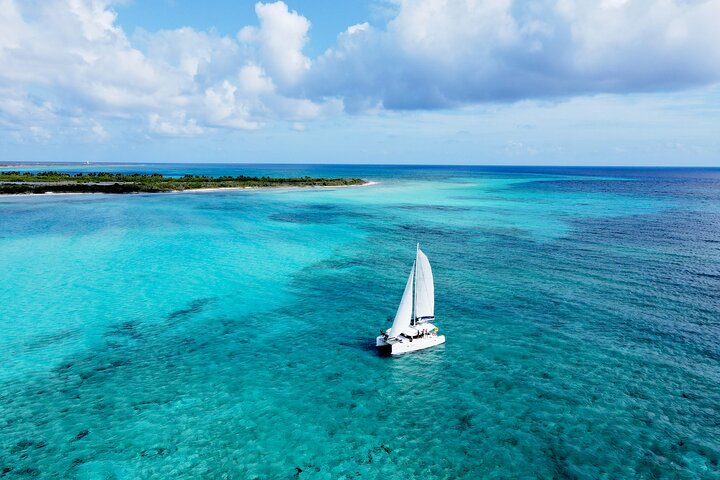Five Hours to El Cielo: Private Catamaran Escape on Cozumel’s Clearest Water
A skip across sapphire shallows to a starfish-studded sandbar—without the crowds
The morning starts with a quiet hum at the marina, palms rustling like they’re sharing secrets with the breeze. A Lagoon 39 catamaran nudges its lines, impatient to move, while the crew checks fins, masks, and the day’s chart. You step aboard, deck warm beneath your feet, and the island exhales behind you. In minutes, the shoreline of Cozumel—low, green, and familiar—drifts away as the hulls skim toward water so clear it refuses to hide anything.
Trail Wisdom
Go Early for Glassy Water
Morning departures typically mean lighter winds and better visibility at the reefs and sandbar.
Hands Off the Starfish
At El Cielo, admire cushion sea stars without lifting or touching them—removing them from water can harm them.
Dress for the Sun, Not the Shade
Wear a UPF rash guard, hat, and reef-safe sunscreen; the wind can mask how strong the sun is.
Mind the Drift
Cozumel’s gentle current can carry you; stay near your guide and let the boat pick you up down-current.
Local Knowledge
Hidden Gems
- •Colombia Shallows—luminous coral gardens perfect for relaxed snorkeling
- •El Cielito—adjacent shallows near El Cielo with a mirror-flat sand bottom
Wildlife
Southern stingray, Cushion sea star
Conservation Note
Use reef-safe sunscreen, never touch starfish or coral, and avoid standing on the reef. Crews anchor on sand to prevent coral damage—follow their lead.
The Cozumel Reefs National Marine Park, established in 1996, protects a vast reef system that has made the island a world-renowned snorkeling and diving destination.
Seasonal Guide
spring
Best for: Calmest seas, Excellent visibility
Challenges: Occasional windy afternoons
March–May often delivers prime conditions with light winds and clear water—ideal for long snorkels and sandbar lounging.
summer
Best for: Warmest water, Long daylight
Challenges: Intense sun exposure, Pop-up squalls
June–August brings bath-warm water and bright color; hydrate often and plan shade breaks on deck.
fall
Best for: Fewer crowds, Warm water
Challenges: Tropical weather risk (peak hurricane season)
September–November can be serene and uncrowded; keep an eye on forecasts and be flexible with rescheduling.
winter
Best for: Cooler air temps, Active marine life
Challenges: Nortes (north winds) can make choppy seas
December–February see refreshing temps and occasional wind; captains favor leeward sites for comfort.
Photographer's Notes
What to Bring
UPF Rash GuardEssential
Sun protection that reduces the need for sunscreen and stays effective when wet.
Reef-Safe Sunscreen (Non-Aerosol)Essential
Protects skin and helps minimize chemical impact on coral and starfish.
Dry Bag (5–10L)
Keeps phones, wallets, and cameras dry during transfers and spray.
Motion Sickness Preventative
If you’re prone to seasickness, take it 30–60 minutes before departure for a smoother day.
Common Questions
What’s included with the private charter?
A professional captain and crew lead a 5-hour private itinerary to El Cielo and prime snorkel sites. Confirm specifics on beverages, snacks, and gear with the operator when booking.
Do I need to be an experienced snorkeler?
No. Basic swimming skills are sufficient and the crew provides a safety briefing and guidance in the water.
Can non-swimmers still enjoy the trip?
Yes. Non-swimmers can relax on deck or enjoy the shallow sandbar at El Cielo; ask the crew about floatation aids.
Where does the boat depart from?
Most trips depart from marinas on Cozumel’s west side; your exact dock and meeting details are provided after booking.
Is the marine park fee included?
Some operators include the Cozumel Reefs National Marine Park fee; others collect it separately. Confirm before your trip and bring small cash if needed.
What’s the best time of day to go?
Morning departures typically offer calmer conditions and brighter water clarity at both the reefs and El Cielo.
What to Pack
Reef-safe sunscreen to protect skin and coral; polarized sunglasses to cut surface glare; light long-sleeve sun shirt for all-day UV defense; small cash for marine park fees and tipping the crew.
Did You Know
Cozumel Reefs National Marine Park protects more than 29,000 acres of coral reefs and marine habitat, designated in 1996 to safeguard one of the Mesoamerican Barrier Reef’s brightest sections.
Quick Travel Tips
Book a morning slot for calmer seas; bring a dry bag for phones and passports; confirm marine park fees in advance; tipping 10–20% for excellent crew service is customary.
Local Flavor
Post-sail, refuel in San Miguel with cochinita pibil at La Choza, grab a craft brew at Cervecería Punta Sur, or time sunset tacos al pastor along Av. Rafael E. Melgar. If you want a sit-down with a view, Buccanos at Night pairs island seafood with a breeze.
Logistics Snapshot
Closest airport: Cozumel International (CZM). Typical departure: west-side marinas (e.g., Marina Fonatur), about 10 minutes by taxi from central San Miguel. Cell service: reliable in-town, spotty offshore. Permits/fees: Cozumel Reefs National Marine Park fee may be required—confirm if included.
Sustainability Note
This trip operates within Cozumel Reefs National Marine Park—pack reusable bottles, avoid single-use plastics, use reef-safe sunscreen, and never touch or remove marine life, including starfish at El Cielo.
Continue Reading

The Pulse of the Gulf: Exploring Cabo Pulmo’s Living Reef
A living reef that fought its way back: Cabo Pulmo is a compact, community-protected marine park where coral gardens and pelagic encounters reward deliberate travel. Here’s how to see it responsibly.
Cabo Pulmo, Baja California Sur

Under the Limestone Roof: Exploring Cenotes Sac Actun’s Subterranean Rivers
Descend into the Yucatán’s submerged cathedral: Sac Actun’s cenotes offer crystalline snorkeling, hushed caverns and a direct link to Maya water lore—best experienced with a local guide and a careful eye.
Tulum, Quintana Roo

